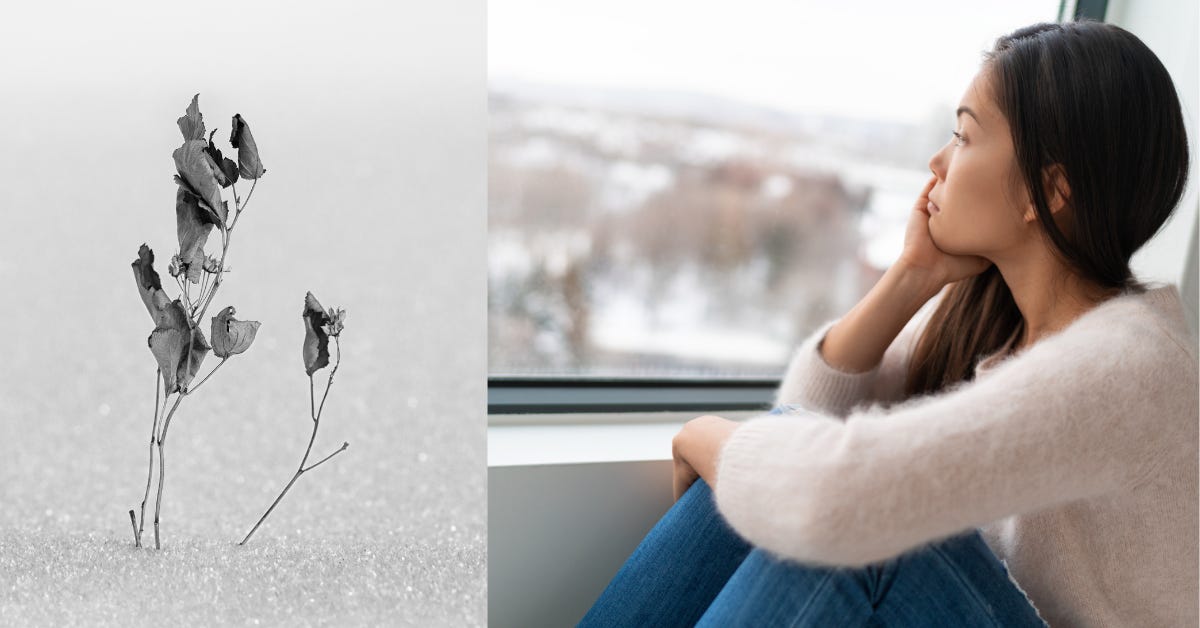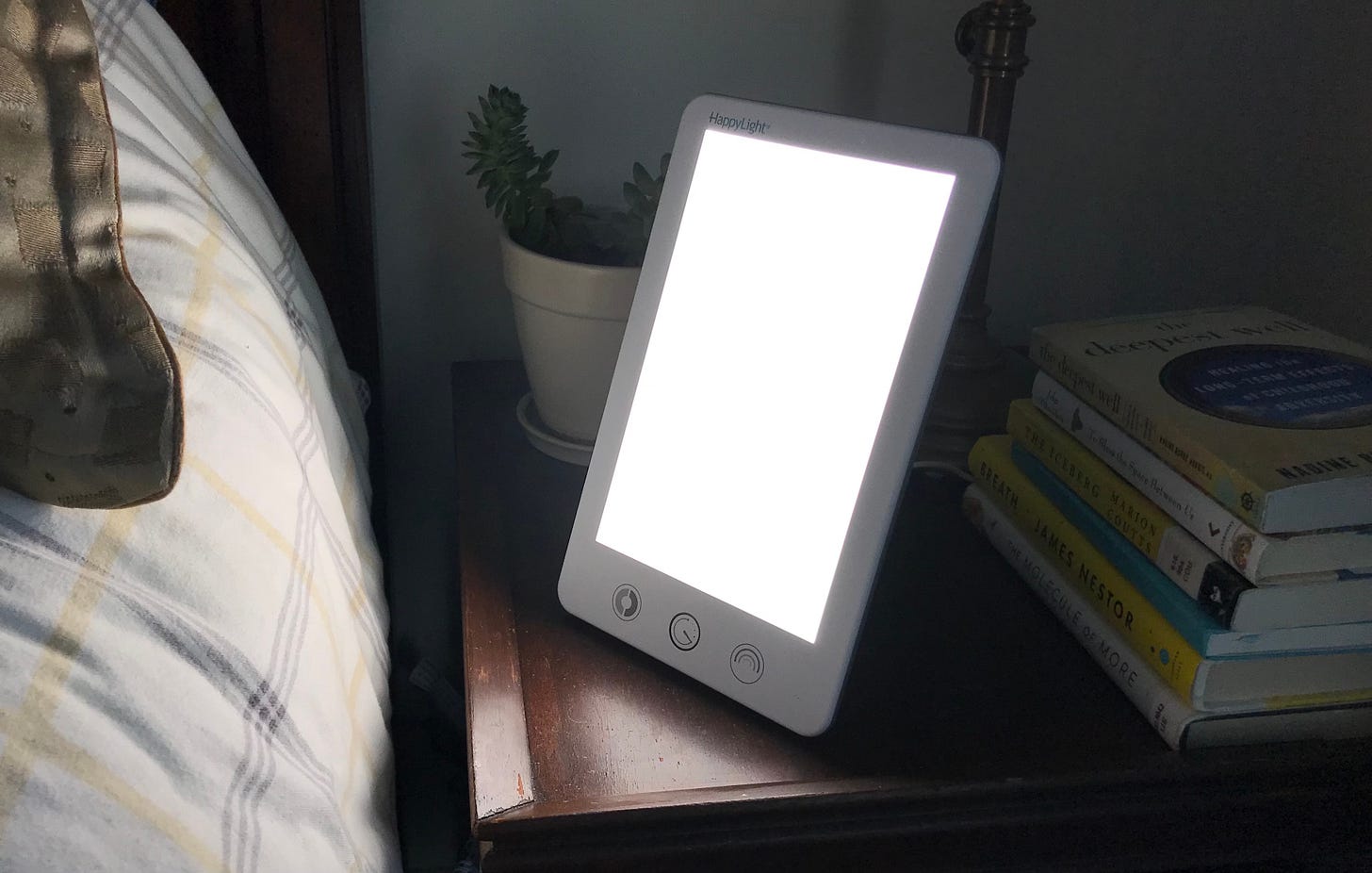This morning, we set the clocks back one hour in the U.S. Our dark evenings will be even darker tonight — the sun will set around 4:45 p.m. today where I live. Ugh. I do not love these early nights.
Winter is a hard season for many people. The energizing glow of sunlight decreases. Sundown creeps earlier. The air turns cold. For many of us, our mood and energy fall.
Experts have studied this shift. Some people use “winter blues” and “SAD (Seasonable Affective Disorder”) interchangeably, but many experts separate them in two different categories. Let’s dig into this.
SAD is a subset of major depression. It’s in the DSM — the official manual of specific mental disorders. The main treatments are light therapy, psychotherapy, vitamin D, and medication, according to the National Institutes of Health.
Winter blues is a milder form and not an official clinical diagnosis. Rather, winter blues is used to refer to increased feelings of sadness, fatigue, and decline in motivation in this season.
Dr. Norman E. Rosenthal was one of the original researchers who noticed and studied SAD, giving it an official classification. In a Q&A with Dr. Steven D Targum, MD in the journal Psychiatry, Dr. Rosenthal explains:
“Every year, as the days become short and dark, people with SAD develop a predictable set of symptoms. They slow down and have a hard time waking up in the morning. Their energy level decreases, they tend to eat more, especially sweets and starches, and they gain weight. Their concentration suffers, and they withdraw from friends and family. As you can imagine, their work and relationships suffer, and they can become quite depressed. This symptom cluster often lasts for four or five months until the days become longer again. Since the syndrome is linked to a lack of light, people with SAD may become depressed during cloudy weather at any time of year, or if they are confined to windowless offices or basement apartments.
“In its full form, SAD affects productivity in work or school, may affect interpersonal relationships, and causes a marked loss of interest or pleasure in most activities. A milder form of seasonal disorder, the winter blues, yields similar symptoms of decreased energy and increased appetite and can also affect enthusiasm and productivity but to a lesser extent.”
Dr. Rosenthal goes on to say that about 6% of the population in America is affected by SAD, and about 14% is affected by winter blues. (Mostly in the northern areas of the country.)
He emphasizes that light therapy can be very helpful:
“Sixty to 80 percent of SAD sufferers benefit from light therapy. The amount of light varies from person to person. The best light therapy units are about 1ft by 1.5ft in surface areas and use white fluorescent lights behind a plastic diffusing screen, which filter out ultraviolet rays. Mornings seem the best time for light therapy to work, although the treatments can be divided during the day. Most people respond to light therapy within 2 to 4 days of initiating treatment. Although the amount of time needed varies, most people need between 30 and 90 minutes (10,000lux) of light therapy per day.”
Read the full Q&A with Dr. Rosenthal.
Here is more about the light box I use, which is a $50 Happy Light.
I do get discouraged by winter; I feel the drag of the darker days, though my Happy Light has made a remarkable difference in the past winter or two. I haven’t felt the severity of SAD, but many people I love experience SAD, and it is so hard. The seeming inevitability of it is terrible. What can help? What can we do, as we look ahead and see winter?
In reading through the articles about winter blues, I was struck by how most of the guidance are things we can do ourselves — not medications or procedures, but rather, activities and habits that get us moving and light us up.
For example, this article from Mayo Clinic on winter blues advises:
“Get outside — There is no substitute for natural light. If you work during the day, try to go for a walk during a break or lunch.
“Light therapy boxes can help boost your mood when you’re unable to get outdoors.
“Get regular exercise — At least three times a week for 30 minutes.
“Stay social — Interact with family and friends on a regular basis.”
Kaiser Permanente physician Dr. Amado Daylo recommends 8 ways to cope with the winter blues in this article:
1. Exercise
2. Check your vitamin D levels
3. Get some light therapy
4. Eat a healthy diet
5. Stimulate your senses
6. Nurture your spirit
7. Head to a sunnier climate
8. See a therapist
I bolded the areas I thought were things that could be done on our own — friends nudging friends to talk walks, to turn on the light box in the morning, to listen to music we love, to paint.
To this end, I’ve been thinking about creating an online gathering for us this winter — called Winter Camp — to help nudge us toward the activities that help light up our winters. It could include virtual live gatherings focused on movement and creativity, perhaps interviews with experts where you could submit questions, and regular prompts for reflection. And there could be an online private space where we could connect with and encourage others. I’ll have more to tell you soon, I hope.
(Note: This post and anything I write or host is not medical advice. I am not a doctor. Please see a healthcare professional for your questions and the needs of your particular body. Doctors can monitor your vitamin D levels and talk to you about whether medication or other interventions could be helpful for you.)
With so many habits in life, I think we often already know what might help, but when our chemicals shift and our motivation is low, it’s difficult to nudge ourselves. It’s hard in the moment to remember the difference it can make to take that walk in the cold falling snow or turn on the sun lamp in the morning, every morning. Perhaps supporting each other this winter could help shift the season for us all.
I’ve love to hear your thoughts.
To our journeys,
Brianne







Thank you Brianne - great insights, and well written. I will definitely stay tuned for ‘winter camp’, and will shoot you an email now. Hope you’re well, M
I am with you in not looking forward to winter. Thanks for the pragmatic tips. I find it interesting that most of these suggestions are also beneficial for those of suffering from chronic conditions to do all year round too.